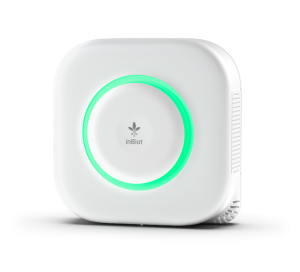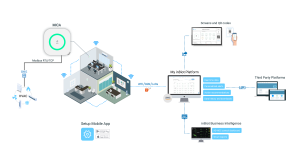

IAQ Monitoring
Indoor Air Quality (IAQ) monitoring is the process of gathering continuous data on gases, particles, chemicals or other ambient parameters measured indoor air. K-HEALTHinAIR uses ioT devices already in available in the market (provided by inBiot and MANN+HUMMEL) for continuous IAQ monitoring in massive monitoring deployed on pilot sites. These IAQ monitoring tools offer a wide variety of selected parameters according to project needs.
The starting point for an indoor air quality monitoring tool is to identify trends in the evolution of indoor air quality throughout a long period of time. Continuous monitoring allows the user to track IAQ changes based on time, occupancy and building activity.
inBiot is a manufacturer of smart and flexible indoor air quality monitoring and management solutions. And, as a partner of the K-HEALTHinAIR consortium, provider of IAQ monitoring solutions in three of the pilot projects.
MICA - inBiot
MICA (Monitor Inteligente de Calidad del aire) is the solution proposed by inBiot, a monitor that measures continuously and in real time the main parameters that define indoor air quality: indoor temperature, relative humidity, CO2, TVOC, formaldehyde, PM1, PM2.5, PM4, PM10.
These tools have universal communication system that ensures the monitoring device connectivity in any indoor space at any location. It has its own cloud developed platform (My inBiot) for transforming the monitored data into useful information for the user, both for the exaustive analysis of the evolution of air quality, and to enable the awareness of building users on indoor air quality.
MICA is a device characterized by its ease of intallation, integration and multiple communication options. The monitors adapt to the needs of any installation with their desktop and wall-mounted versions:
Through Modbus RTU (RS485) and Modbus TCP (wireless) communication protocols, MICA can be integrated with BMS (Building Management System) systems for HVAC system regulation. In this way, it is possible to automate the operation of the equipment to achieve significant energy savings while guaranteeing optimum air quality levels at all times.
For the visualization of the collected data, MICA devices offer different possibilities of connectivity to the cloud:
inBiot’s IAQ Monitors use end-to-end SSL / TLS encryption, MQTT communication to ensure maximum security in data transfer between IoT devices and the AWS cloud infrastructure, as well as a public API that allows easy integration with other platforms and third party developments for data visualization.

Calibration
MICAs use a modular sensor design that does not need re-calibration over time, and sensor can easily be changed by replacing the sensor modules when lifespan is over. However, inBiot’s commitment to quality and accuracy goes beyond standard calibration practices. It starts with the careful selection of sensors by its own engineering team. All sensors undergo individual calibration using transfer standards prior to assembly in accordance with ISO9001:2015 and ISO/IEC 17025:2017. This meticulous calibration process ensures that each sensor complies with the specifications indicated in the corresponding data sheets. In addition, each sensor is individually tested after calibration, validating its performance and accuracy.
Once installed, all MICA Monitors use Baseline Calibration Self-Correction and/or Automatic Self-Calibration algorithms (AC algorithms). When the air quality monitor detects a deviation or change in the baseline value due to factors such as changes in indoor spaces, it automatically adjusts the calibration internally. With this algorithm, MICA monitors their own readings and compare them to known reference values. Thus, through advanced algorithms, it corrects the measurements to maintain accuracy and ensure maximum long-term stability without the need for manual actions by the user.

Funded by the European Union. Views and opinions expressed are however those of the author(s) only and do not necessarily reflect those of the European Union or of the European Health and Digital Executive Agency (HADEA). Neither the European Union nor the granting authority can be held responsible for them.